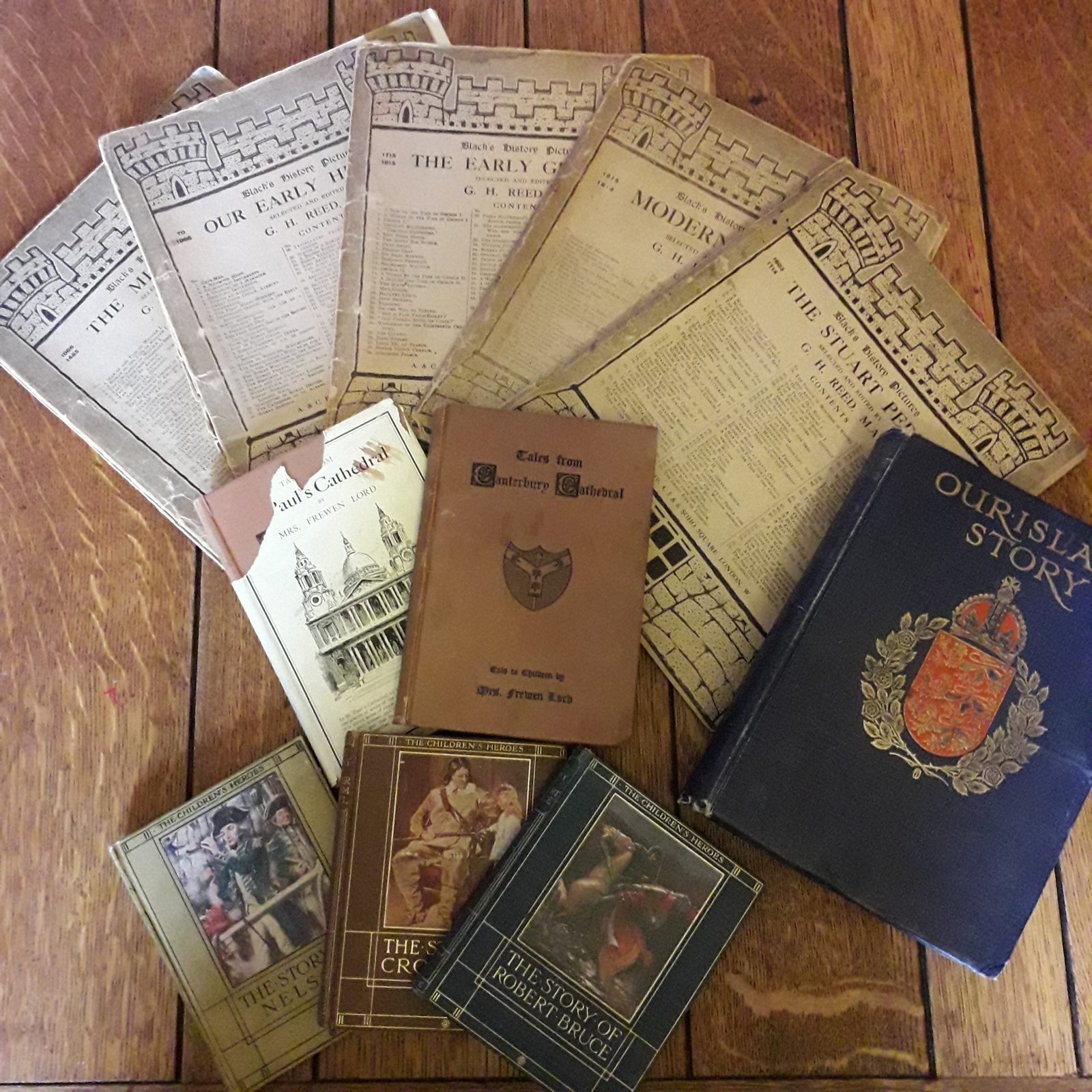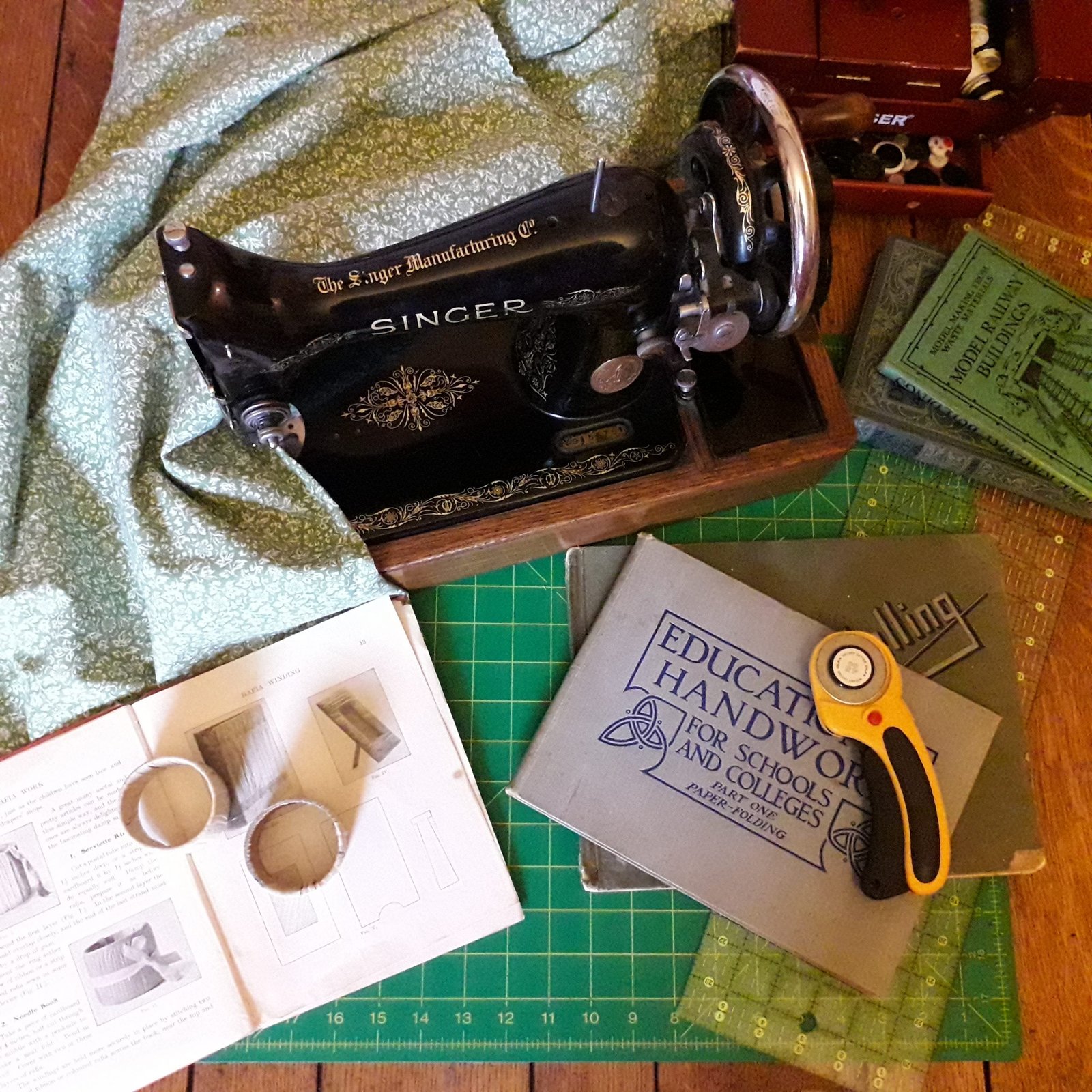Scheduling
2 × 20 minute lessons per week. The second lesson is optional. The P.U.S. programmes state that “A second lesson to be taken on Saturday, 9.20-9.40, otherwise pages read with omissions,” so should the teacher decide to schedule just one lesson a week then she may find cause to make omissions when reading the term’s text.
School Books and Material Covered
There were two main texts studied side-by-side during the six terms that make up Form IA; and possibly supplemented with some short biographies, charts, and pictures, as follows:
(a) The main history spine (left over from IB; completed over two years)
(b) A book of historical stories (one per year), covering a wide span of history
(c) Biographies (optional)
(d) Charts and Pictures (optional)
(a) Main History Spine
Students in Form IA continued their reading of Our Island Story, by H. E. Marshall from where the rest of the form is at that point. The six-term rotation of the remaining two thirds of the text always started in 1199 on page 1681 (chapter 35); this could potentially propel the student several hundred years ahead of where they left off.
“Children of seven are promoted to Form IA in which they remain for a couple of years. They read from the same capital book, Mrs. Marshall’s Our Island Story, and about the same number of pages in a term; but while the readings in IB are confined to the first third of the book embodying the simpler and more direct histories, those in IA go on to the end of the volume and children learn at any rate to love English history. “I’d a lot sooner have history than my dinner,” said a sturdy boy of seven by no means inclined to neglect his dinner.”
[Vol. VI, p. 174]
They would read an average of fifty-seven pages a term and the P.U.S. suggested rotation for these books is listed below (please note that later editions of Our Island Story included about 38 extra pages, very briefly describing the death of Queen Victoria, reign of Edward VII, and the Great War of 1914):

(b) Historical Stories
“Mrs. Frewen Lord’s delightful Tales from Westminster Abbey and from St. Paul’s help the children immensely in individualising their heroes. It is good to hear them ‘tell’ of Franklin, Nelson, Howard, Shaftesbury, and their delight in visiting the monuments is very great. One would not think that Donne would greatly interest children but the excitement of a small party in noticing the marks of the Great Fire still to be seen on his monument was illuminating to lookers-on.”
[Vol. VI, p. 174]
In addition to the main spine, students in IA would each term read a few chapters from a book series by Mrs. Frewen Lord, either Tales from Westminster Abbey, Tales from Canterbury Cathedral, or Tales from St. Paul’s Cathedral.
Charlotte Mason described these books as “little volumes in which children delight, which feed patriotic sentiment and lay a broad basis for historical knowledge.” She said, “It is a beautiful and delightful thing to take children informed by these tales to the Abbey or St Paul’s, and let them identify for themselves the spots consecrated to their heroes. They know so much and are so full of vivid interest that their elders stand by instructed and inspired.” [Vol. I, p. 289].
These relatively short historical accounts would walk a student through the Cathedral or Abbey, describing the monuments they come across, and relating historical events as they occurred either within the building itself or to the figures connected with the location in question. They would read one of these ‘Tales’ per school year so that only two out of the three editions would be read by a Form I student. Approximately 40 pages2 would be covered per term.
The P.U.S. suggested rotation for these books is listed below:
Tales from St. Paul’s Cathedral

Tales from Canterbury Cathedral

Tales from Westminster Abbey

(c) Biographies
“In IA the history is amplified and illustrated by short biographies of persons connected with the period studied, Lord Clive, Nelson, etc.”
[Vol. VI, p. 174]
In a couple of the earlier P.U.S. programmes the students would also be assigned one short biography a term. The biography chosen was generally about a person contemporary with the time period being studied, and was chosen from a book series entitled, The Children’s Heroes.3
(d) Charts and Pictures
Also in a few of the earlier P.U.S. programmes, the students in Form IA made use of pictures related to the time period being studied. These were assigned from a set called Black’s History Pictures, by G. H. Reed, and included “portraits of eminent persons, photographs of arms, relics, old prints, castles, sites, etc.; plans and maps […] Most of the originals are in our public galleries, and all are by well-known artists.”4 The series also included questions for discussion; however I think it unlikely these would have been used in a P.U.S classroom. These particular pictures were no longer specified on the programmes after Charlotte’s death
Further Reading
Notes of Lessons: English History, Class Ib5
Notes of Lessons: History, Class Ib: Westminster Abbey
Printables
Footnotes
- All page numbers refer to the book edition that the P.U.S. assigned in the original programmes. This may not transfer to modern reprints. [↩]
- Based on two history lessons a week over an eleven week term (excluding time allowed for exams in the twelfth week). [↩]
- These biographies were dropped from the history programme after Charlotte Mason’s death, but found their way instead into the Sunday reading portion of the programmes. [↩]
- Taken from the Editor’s Note in Black’s History Pictures series. [↩]
- Do not be confused! Class Ib is equivalent to Form IA. In 1915 the P.U.S. changed from classes I-IV to forms I-VI, and with this the meaning of A & B changed too! [↩]







